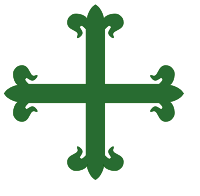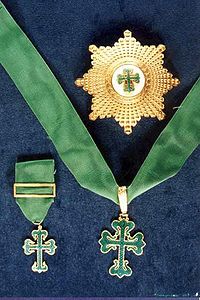Order of Avis
The Knightly Order of Aviz or Avis ( Ordem Militar de São Bento de Aviz ), also known as the Order of St. Benedict of Avis , was an order of knights in Portugal , which was named after its seat, the city of Avis . An order of the Portuguese Order of Merit is awarded under the same name today .
history
The symbol of the order was traditionally a green cross often depicted with lily-shaped ends. The ribbon was green. Ceremonial clothing consisted of a white coat with a lily cross .
A whole series of legends are connected with the history of this order, which are often said to prove that the history of the Portuguese Aviz knights is older than that of the Castilian Calatrava order , from whose community they broke away at the end of the 14th century.
It is largely certain that the Portuguese order of knights of Aviz originally emerged from a brotherhood of knights ( confraria de cavaleiros ) founded in Coimbra in 1162 to fight the Moors . The king commissioned the knights of the brotherhood to defend the city of Évora , which had been conquered by the Moors in 1159, against their counterattacks.
After 1166, the brotherhood was converted into a religious knightly order by the Portuguese King Alfonso I (Dom Afonso I Henriques) and initially referred to as the Order of Évora after its seat. Its first master in Portugal was the military commander of Lisbon and Estremadura , Gonçalo Viegas de Lanhoso , between 1175 and 1195 .
Around 1187, the superiors of the order adopted the rule of the Knights of Calatrava. Henceforth they were considered to be the Militia of Évora the Calatrava Knights ( Milícia de Évora da Ordem de Calatrava ), d. H. as the Portuguese branch of this Castilian order. The knights of the order vowed poverty, chastity and obedience as well as the fight against the Moors. In addition to the Knights of the Order there was, as in other orders, the large group of lay brothers who were not or not fully subject to these strict rules.
King Alfonso II handed the fortress and city of Aviz over to the knights under their master Fernando Annes in 1211. The order fortified the city, expanded the fortress and built its convent building here. In 1223 and 1224, the entire Évora militia moved to Aviz under their master Fernão Rodrigues Monteiro and since then has been known as the Order of Aviz. In 1248, the Avis knights under their master Martím Fernandes distinguished themselves during the siege and conquest of the Andalusian city of Seville led by Ferdinand the Saint , which Ferdinand then incorporated into his kingdom of Castile.
Although the Aviz Order was formally subordinate to the Grand Master of the Castilian Calatrava Knights, who u. a. also had to confirm the choice of the master of the Évora militia, the Aviz order had a clear “national-Portuguese” component and a strongly autonomous character since its foundation. Politically, the Avis knights were committed to and dependent on the Portuguese king from the start, who made extensive donations of land to them.
Among other orders, the Aviz Knights were an important military and economic bearer of the Portuguese Reconquista . After this came to an end with the conquest of the Algarve in the middle of the 13th century, the Aviz knights' dependence on the Calatrava order became a growing danger for the Portuguese kings in their latent rivalry with Castile. Therefore, the Portuguese royal family began to withdraw the wealthy in Portugal Ritterorden the Castilian influence and with the Order of Christ , in the dissolved Templars rose to create a national military orders for the continuation of the Reconquista in North Africa with the approval of the papacy.
Especially since Prince John was appointed Master of Aviz Knights in 1363, against the express resistance of Castile when John I became King of Portugal, these disputes also took place in the Aviz Order. In 1387, the Aviz knights chose Fernando Rodrigues de Sequeira as their master without obtaining the consent of the Grand Master of the Calatrava Order. 1389 confirmed Pope Boniface IX. this choice. With that the Knights of Aviz had finally broken away from the association with the Order of Calatrava. In 1434 the Infante Ferdinand von Avis took over the office of Grand Master, which from then on always remained in the ranks of the Portuguese royal family. It was not until 1440 that Castile finally recognized the independence of the Aviz knights. After Ferdinand's death in captivity by the Moors on June 5, 1443, Peter of Aragón , the 15-year-old son of the Infante and regent of Portugal, Peter of Portugal , was appointed Grand Master of the Aviz Knights in 1444 .
In 1789 Queen Maria I secularized all orders, including the order of the Aviz Knights.
In 1894 a military order of merit for members of the armed forces a. a. The country's armed forces were formed with three classes: Grand Cross, Commander and Knight.
Since the reform of 1986, the Portuguese President has been the so-called Grand Master at the head of the order, which can only be awarded to domestic and foreign military personnel for military services in five classes.
Classes
The order today consists of five classes.
Grandmaster
The Grand Masters of the Knightly Order were:
- Gonçalo Viegas de Lanhoso (1176–1195)
- Paio (1200)
- Fernando Anes (1201-1221)
- Fernando Rodrigues Monteiro (1222–1237)
- João "Porteiro"
- Martím Fernandes (1238-1264)
- Pedro Afonso (1268-1269)
- Simão Soares (1269-1280)
- Egas Martins de Outeiro (1280-1290)
- Fernão Soares
- João Peres (1291-1292)
- Joao Afonso (1294)
- Lourenço Afonso (1296-1310)
- García Peres de Casal (1311-1316)
- Gil Martins de Outeiro (1316-1319)
- Vasco Afonso (1320-1329)
- Gil Peres de Noudar (1330-1332)
- Afonso Mendes (1334)
- Gonçalo Vasques (1336-1341)
- João Rodrigues Pimentel (1342-1351)
- João Afonso de Pena de Aguiar (1351-1356)
- Diogo García
- Martím de Avelar (1357-1363)
- Egas Martins
- João I of Portugal (1363-1385)
- Fernando Rodrigues de Siqueira (1387-?) (Administrator)
- Fernando of Portugal (1434–1443)
- Pedro of Portugal (1445–1466)
- João II of Portugal (1468–1490)
- Afonso of Portugal (1490-1491)
- Jorge of Lancastre (1491–1551)
Brazilian Order
The Brazilian Order originally corresponded to the Portuguese Avizorden, which was established as a political and non-military order for Brazil by the law of October 20, 1823 and determined more precisely on September 9, 1843. The grades and badges remained the same, only the green ribbon was trimmed in red.
See also
- Religious order
- List of religious orders
- List of Portuguese orders and decorations
- Order of knights
- History of Portugal
- Timeline of the history of Portugal
literature
- Alain Demurger: The Knights of the Lord. History of the spiritual orders of knights. Beck, Munich 2003, ISBN 3-406-50282-2 .
- Hermann Weiss: Costume customer. History of costume and equipment in the Middle Ages from the 4th to the 14th century. Ebner and Seubert, Stuttgart 1864
Web links
- Order of Avis (images) , Phaleristics Academy of Portugal (English)

